

Integrating Web 2.0 Tools into the Classroom: Changing the Culture of Learning. June 1, 2010 This report presents findings from a two-year investigation of the ways in which Web 2.0 tools and social networking technologies are being used to support teaching and learning in classrooms across the United States. With funding from Intel®, the Education Development Center's Center for Children and Technology (EDC/CCT) interviewed or visited over 30 educators in 22 different schools throughout the country as they employed these tools in their classrooms in innovative ways. We also spoke with and observed a number of students in these schools. Currently, there is much discussion and excitement about Web 2.0 in education, but we still know very little about how these tools actually work in the classroom. Selecting Technologies. This page helps you choose among various technologies (not just LMSs) using two approaches:
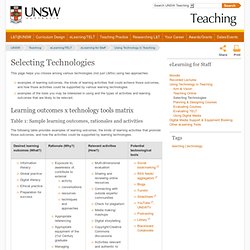
Collaboration and competition on a wiki: The praxis of online social learning to improve academic writing and research in under-graduate students. Using VoiceThread to Build Student Engagement - Faculty Focus. Online educators have long known that asynchronous discussion is deeper than face-to-face discussion due to the increased thought time and the “democratization” of the classroom.
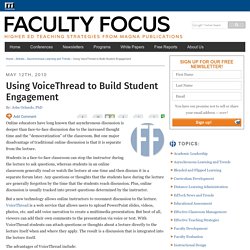
But one major disadvantage of traditional online discussion is that it is separate from the lecture. Students in a face-to-face classroom can stop the instructor during the lecture to ask questions, whereas students in an online classroom generally read or watch the lecture at one time and then discuss it in a separate forum later. Any questions or thoughts that the students have during the lecture are generally forgotten by the time that the students reach discussion. Plus, online discussion is usually tracked into preset questions determined by the instructor. Harris.pdf. Teaching with Technology Collaboratory - Benefits of Using Discussion Boards in Your Classes. What is flipped classroom. 3_Kalantzis_ELEA_7_3_web.pdf. MOOCs, MIT and Magic. JOLT - Journal of Online Learning and Teaching. Natalia V.
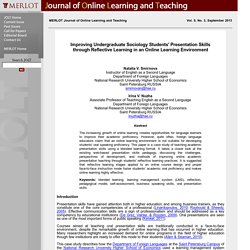
Smirnova Instructor of English as a Second Language Department of Foreign Languages National Research University Higher School of Economics Saint Petersburg RUSSIA smirnovan@hse.ru Irina V. Nuzha Associate Professor of Teaching English as a Second Language Department of Foreign Languages National Research University Higher School of Economics Saint Petersburg RUSSIA inuzha@hse.ru Introduction Presentation skills have gained attention both in higher education and among business trainers, as they constitute one of the core competencies of a professional (Linardopoulos, 2010; Raybould & Sheedy, 2005).
Courses aimed at teaching oral presentation skills are traditionally conducted in a face-to-face environment, despite the remarkable growth of online learning that has occurred in higher education. [ARCHIVED] Studies of e-portfolio implementation (videos and toolkit) : Jisc. Two online resources providing guidance on large-scale implementation of e-portfolio tools in UK further and higher education are available to supplement the 2008 JISC publication, Effective Practice with e-Portfolios The online resources, five video case-studies and an online toolkit for managers and practitioners, explore the issues, challenges and benefits of scaling up e-portfolio use across a university or college, and offer opportunities to explore the pros and cons of different approaches and methodologies.
![[ARCHIVED] Studies of e-portfolio implementation (videos and toolkit) : Jisc](http://cdn.pearltrees.com/s/pic/th/portfolio-implementation-112672783)
Hallas.pdf.
Pedagogy 2.0. The Rapid eLearning Blog - Practical, real-world tips for e-learning success. Creating great interactive learning experiences requires a few core building blocks: relevant content, pull versus push, and real-world decisions.
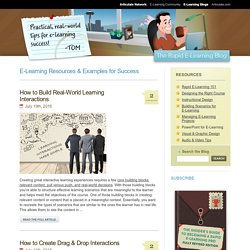
With those building blocks you're able to structure effective learning scenarios that are meaningful to the learner and helps meet the objectives of the course. One of those building blocks in creating relevant content or content that is placed in a meaningful context. Essentially, you want to recreate the types of scenarios that are similar to the ones the learner has in real life. This allows them to see the content in ... Read the full article After last week's post on the different drag & drop interaction examples, I had quite a few emails asking for tips on how to create drag and drop interactions for elearning.
Sliders are used as a means to make adjustments/selections or as a simple way to navigate content. It helps to look at what others are doing to get ideas and inspiration for your own work. Create ... TEC-Variety_eBook_5-4.pdf. iPads in Education - Exploring the use of iPads and mobile devices in education. The Teacher's Quick Guide To Digital Scavenger Hunts. If you’ve got a smartphone or a tablet in your classroom, you’re ready for the adventure to begin!
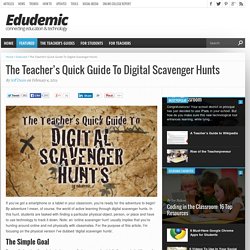
By adventure I mean, of course, the world of active learning through digital scavenger hunts. In this hunt, students are tasked with finding a particular physical object, person, or place and have to use technology to track it down. Note: an ‘online scavenger hunt’ usually implies that you’re hunting around online and not physically with classmates. For the purpose of this article, I’m focusing on the physical version I’ve dubbed ‘digital scavenger hunts’. OLT: Flipped Classroom Project. The Teacher's Guide To Flipped Classrooms. Since Jonathan Bergman and Aaron Sams first experimented with the idea in their Colorado classrooms in 2004, flipped learning has exploded onto the larger educational scene.
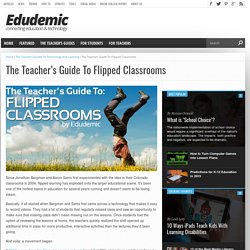
It’s been one of the hottest topics in education for several years running and doesn’t seem to be losing steam. Basically, it all started when Bergman and Sams first came across a technology that makes it easy to record videos. Www.tedi.uq.edu.au/downloads/Biggs_Solo.pdf. Constructive Alignment - and why it is important to the learning process. What is Constructive Alignment?

Constructive Alignment, a term coined by John Biggs (Biggs, 1999) is one of the most influential ideas in higher education. Choosing Technology. UNSW Teaching Staff Gateway. E-Learning Challenges. The weekly challenges are ongoing opportunities to learn, share, and build your e-learning portfolios.

You can jump into any or all of the previous challenges anytime you want. I’ll update the recap posts to include your demos. Even if you’re using a trial version of Studio ’13 or Storyline, you can absolutely publish your challenge files. Just sign up for a fully functional, free 30-day trial, and have at it. And remember to post your questions and comments in the forums; we're here to help. If you have a blog, please consider writing about your challenges. The worlds largest flipped classroom. This is a special guest post by associate professor Carl Reidsema from the University of Queensland.
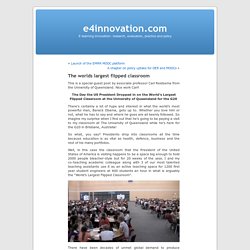
Nice work Carl! The Day the US President Dropped in on the World’s Largest Flipped Classroom at the University of Queensland for the G20 There’s certainly a lot of hype and interest in what the world’s most powerful man, Barack Obama, gets up to. Whether you love him or not, what he has to say and where he goes are all keenly followed. So imagine my surprise when I find out that he’s going to be paying a visit to my classroom at The University of Queensland while he’s here for the G20 in Brisbane, Australia! So what, you say?